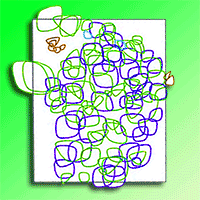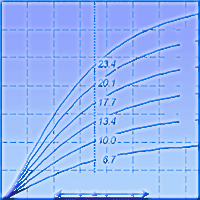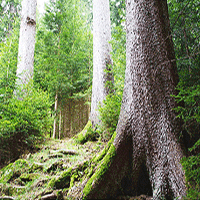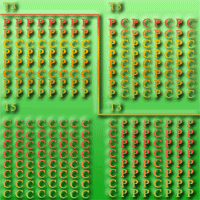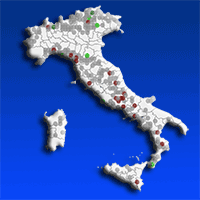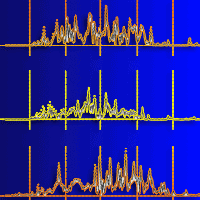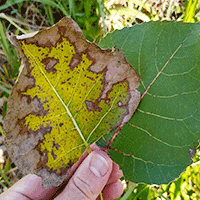Interactions between tree species determine the dynamics of forest communities. Spatial and temporal changes in resource availability, variation in species composition and spatial distribution of trees may alter competitive interactions between species and, therefore, affect tree growth and forest productivity. In this study, we analyzed the intra and inter-specific interactions between European beech (Fagus sylvatica L.) and silver fir (Abies alba Mill.) in southern Italy (Molise and Calabria regions), and how these interactions affect basal area increments in mixed-species and pure stands. Results showed that intra-specific interactions have a negative effect on the basal area increment, both in pure and mixed-species stands of Molise and Calabria. Basal area increment was higher influenced by intra-specific interactions in pure stands than in mixed-species stands. Silver fir in Molise showed higher basal area increment in mixed-species stand, probably in relation with stand structure and space occupation that resulted in less competition between individual trees. European beech showed high values of intra-specific interactions in pure stands, likely related to the low self-tolerance of this species and to the spatial arrangement of trees, due to canopy closure. The absence of inter-specific interactions in mixed-species stands could be explained by the sub-dominant position of European beech, which may have limited the benefit derived from niche separation and complementarity for silver fir.
Keywords
, , , , ,
Citation
Versace S, Garfì V, Dalponte M, Febbraro Mirko D, Frizzera L, Gianelle D, Tognetti R (2021). Species interactions in pure and mixed-species stands of silver fir and European beech in Mediterranean mountains. iForest 14: 1-11. - doi: 10.3832/ifor3476-013
Academic Editor
Giorgio Vacchiano
Paper history
Received: Apr 20, 2020
Accepted: Oct 26, 2020
First online: Jan 02, 2021
Publication Date: Feb 28, 2021
Publication Time: 2.27 months
© SISEF - The Italian Society of Silviculture and Forest Ecology 2021
Open Access
This article is distributed under the terms of the Creative Commons Attribution-Non Commercial 4.0 International (https://creativecommons.org/licenses/by-nc/4.0/), which permits unrestricted use, distribution, and reproduction in any medium, provided you give appropriate credit to the original author(s) and the source, provide a link to the Creative Commons license, and indicate if changes were made.

Breakdown by View Type
(Waiting for server response...)
Article Usage
Total Article Views: 38778
(from publication date up to now)
Breakdown by View Type
HTML Page Views: 30904
Abstract Page Views: 3643
PDF Downloads: 3573
Citation/Reference Downloads: 6
XML Downloads: 652
Web Metrics
Days since publication: 1829
Overall contacts: 38778
Avg. contacts per week: 148.41
Article Citations
Article citations are based on data periodically collected from the Clarivate Web of Science web site
(last update: Mar 2025)
Total number of cites (since 2021): 9
Average cites per year: 1.80
Publication Metrics
by Dimensions ©
Articles citing this article
List of the papers citing this article based on CrossRef Cited-by.
(1)
Ammer C (2019)Diversity and forest productivity in a changing climate. New Phytologist 221 (1): 50-66.
CrossRef |
Gscholar
(2)
Antonucci S, Rossi S, Lombardi F, Marchetti M, Tognetti R (2019)Influence of climatic factors on silver fir xylogenesis along the Italian Peninsula. IAWA journal 40 (2): 259-275.
CrossRef |
Gscholar
(3)
Aussenac R, Bergeron Y, Gravel D, Drobyshev I (2019)Interactions among trees: a key element in the stabilising effect of species diversity on forest growth. Functional Ecology 33 (2): 360-367.
CrossRef |
Gscholar
(4)
Barton K (2013)MuMln: multi-model inference. R Package Version 1.9.5.
Online |
Gscholar
(5)
Bates D, Maechler M, Bolker B, Walker S (2014)lme4: Linear mixed-effects models using Eigen and S4. R package version 1: 1-23.
Online |
Gscholar
(6)
Biging GS, Dobbertin M (1992)A comparison of distance-dependent competition measures for height and basal area growth of individual conifer trees. Forest Science 38 (3): 695-720.
Online |
Gscholar
(7)
Biging GS, Dobbertin M (1995)Evaluation of competition indices in individual tree growth models. Forest Science 41 (2): 360-377.
Online |
Gscholar
(8)
Biondi F (1999)Comparing tree-ring chronologies and repeated timber inventories as forest monitoring tools. Ecological Application 9 (1): 216-227.
CrossRef |
Gscholar
(9)
Bošela M, Petráš R, Sitková Z, Priwitzer T, Pajtík J, Hlavatá H, Sedmák R, Tobin B (2014)Possible causes of the recent rapid increase in the radial increment of silver fir in the Western Carpathians. Environmental Pollution 184: 211-221.
CrossRef |
Gscholar
(10)
Bošela M, Tobin B, Seben V, Petráš R, Larocque GR (2015)Different mixtures of Norway spruce, silver fir, and European beech modify competitive interactions in central European mature mixed forests. Canadian Journal of Forest Research 45 (11): 1577-1586.
CrossRef |
Gscholar
(11)
Brassard BW, Chen HY, Cavard X, Laganière J, Reich PB, Bergeron Y, Paré D, Yuan Z (2013)Tree species diversity increases fine root productivity through increased soil volume filling. Journal of Ecology 101 (1): 210-219.
CrossRef |
Gscholar
(12)
Brooker RW (2006)Plant-plant interactions and environmental change. New Phytologist 171 (2): 271-284.
CrossRef |
Gscholar
(13)
Coates KD, Lilles EB, Astrup R (2013)Competitive interactions across a soil fertility gradient in a multispecies forest. Journal of Ecology 101 (3): 806-818.
CrossRef |
Gscholar
(14)
Condés S, Del Río M, Sterba H (2013)Mixing effect on volume growth of
Fagus sylvatica and
Pinus sylvestris is modulated by stand density. Forest of Ecology and Management 292: 86-95.
CrossRef |
Gscholar
(15)
Conte E, Lombardi F, Battipaglia G, Palombo C, Altieri S, La Porta N, Marchetti M, Tognetti R (2018)Growth dynamics, climate sensitivity and water use efficiency in pure
vs. mixed pine and beech stands in Trentino (Italy). Forest of Ecology and Management 409: 707-718.
CrossRef |
Gscholar
(16)
Daniels RF (1976)Simple competition indices and their correlation with annual loblolly pine tree growth. Forest Science 22 (4): 454-456.
Online |
Gscholar
(17)
Daniels RF, Burkhart HE, Clason TR (1986)A comparison of competition measures for predicting growth of loblolly pine trees. Canadian Journal of Forest Research 16 (6): 1230-1237.
CrossRef |
Gscholar
(18)
Del Río M, Condés S, Pretzsch H (2014)Analyzing size-symmetric
vs. size-asymmetric and intra-vs. inter-specific competition in beech (
Fagus sylvatica L.) mixed stands. Forest of Ecology and Management 325: 90-98.
CrossRef |
Gscholar
(19)
Dormann CF, Elith J, Bacher S, Buchmann C, Carl G, Carré G, García Marquéz JR, Gruber B, Lafourcade B, Leitão PJ, Münkemüller T, McClean C, Osborne PE, Reineking B, SchröDer B, Skidmore AK, Zurell D, Lautenbach S (2013)Collinearity: a review of methods to deal with it and a simulation study evaluating their performance. Ecography 36 (1): 27-46.
CrossRef |
Gscholar
(20)
Forrester DI, Vanclay JK, Forrester RI (2011)The balance between facilitation and competition in mixtures of
Eucalyptus and
Acacia changes as stands develop. Oecologia 166 (1): 265-272.
CrossRef |
Gscholar
(21)
Forrester DI (2014)The spatial and temporal dynamics of species interactions in mixed-species forests: from pattern to process. Forest of Ecology and Management 312: 282-292.
CrossRef |
Gscholar
(22)
Forrester DI, Albrecht AT (2014)Light absorption and light-use efficiency in mixtures of
Abies alba and
Picea abies along a productivity gradient. Forest of Ecology and Management 328: 94-102.
CrossRef |
Gscholar
(23)
Forrester DI, Bauhus J (2016)A review of processes behind diversity productivity relationships in forests. Current Forestry Reports 2 (1): 4-61.
CrossRef |
Gscholar
(24)
Fox J, Weisberg S, Adler D, Bates D, Baud-Bovy G, Ellison S, Firth D, Friendly M. Gorjanc G, Graves S (2012)Package “car”. R Foundation for Statistical Computing, Vienna, Austria.
Online |
Gscholar
(25)
Fraver S, D’Amato AW, Bradford JB, Jonsson BG, Jönsson M, Esseen PA (2014)Tree growth and competition in an old-growth
Picea abies forest of boreal Sweden: influence of tree spatial patterning. Journal of Vegetation Science 25 (2): 374-385.
CrossRef |
Gscholar
(26)
Gamfeldt L, Snäll T, Bagchi R, Jonsson M, Gustafsson L, Kjellander P, Riuz-Jaen MC, Fröberg M, Stendahl J, Philipson CD, Mikusinski G, Andersson E, Westerlund B, Andrén H, Moen J, Bengtsson J (2013)Higher levels of multiple ecosystem services are found in forests with more tree species. Nature Communications 4 (1): 59.
CrossRef |
Gscholar
(27)
Gazol A, Camarero J, Gomez-Aparicio JL (2016)Functional diversity enhances silver fir growth resilience to an extreme drought. Journal of Ecology 104: 1063-1075.
CrossRef |
Gscholar
(28)
Grissino-Mayer HD (2001)Evaluating crossdating accuracy: a manual and tutorial for the computer program COFECHA. Tree Ring Research 57: 205-221.
Online |
Gscholar
(29)
Grossiord C, Granier A, Ratcliffe S, Bouriaud O, Bruelheide H, Chećko E, Forrester DI, Dawud SM, Finér L, Pollastrini M, Scherer-Lorenzen M, Valladares F, Bonal D, Gessler A (2014)Tree diversity does not always improve resistance of forest ecosystems to drought. Proceedings of the National Academy of Sciences USA 111 (41): 14812-14815.
CrossRef |
Gscholar
(30)
Hegyi F (1974)A simulation model for managing jack-pine stands simulation (Fries J ed). Royal College of Forestry, Stockholm, Sweden, pp. 74-90.
Gscholar
(31)
Holmes RL, Adams RK, Fritts HC (1986)Tree-ring chronologies of western North America: California, eastern Oregon and northern Great Basin with procedures used in the chronology development work including users manuals for computer programs COFECHA and ARSTAN. Chronology Series VI, University of Arizona, Tucson, AZ, pp. 185.
Online |
Gscholar
(32)
Jactel H, Brockerhoff EG (2007)Tree diversity reduces herbivory by forest insects. Ecology Letters 10 (9): 835-848.
CrossRef |
Gscholar
(33)
Klein T (2014)The variability of stomatal sensitivity to leaf water potential across tree species indicates a continuum between isohydric and anisohydric behaviours. Functional Ecology 28: 1313-1320.
CrossRef |
Gscholar
(34)
Lebourgeois F, Gomez N, Pinto P, Mérian P (2013)Mixed stands reduce
Abies alba tree-ring sensitivity to summer drought in the Vosges mountains, western Europe. Forest of Ecology and Management 303: 61-71.
CrossRef |
Gscholar
(35)
Liang J, Crowther TW, Picard N, Zhou M, Alberti G, Schulze E-D, McGuire AD, Bozzato F, Pretzsch H, De-Miguel S, Paquette A, Hérault B, Scherer-Lorenzen M, Barrett CB, Glick HB, Hengeveld GM, Nabburs G-J, Pfautsch S, Viana H, Vibrans AC, Ammer C, Schall P, Verbyla D, Tchebakova N, Fischer M, Watson JV, Chen HYH, Lei X, Schelhaas M-J, Lu H, Gianelle D, Parfenova EI, Salas C, Lee E, Lee B, Kim HS, Bruelheide H, Coomes DA, Piotto D, Sunderland T, Schmid B, Gourlet-Fleury S, Sonké B, Tavani R, Zhu J, Brandl S, Vayreda J, Kitahara F, Searle EB, Neldner VJ, Ngugi MR, Baraloto C, Frizzera L, Balazy R, Oleksyn J, Zawila-Niedzwiecki T, Bouriaud O, Bussotti F, Finér L, Jaroszewicz B, Jucker T, Valladares F, Jagodzinski AM, Peri PL, Gonmadje C, Marthy W, O’Brien T, Martin EH, Marshall AR, Rovero F, Bitariho R, Niklaus PA, Alvarez-Loayza P, Chamuya N, Valencia R, Mortier F, Wortel V, Engone-Obiang NL, Ferreira LV, Odeke DE, Vasquez RM, Lewis SL, Reich PB (2016)Positive biodiversity-productivity relationship predominant in global forests. Science 354 (6309): aaf8957.
CrossRef |
Gscholar
(36)
Linares JC, Camarero JJ, Carreira JA (2010)Competition modulates the adaptation capacity of forests to climatic stress: insights from recent growth decline and death in relict stands of the Mediterranean fir
Abies pinsapo. Journal of Ecology 98 (3): 592-603.
CrossRef |
Gscholar
(37)
Lorimer CG, Dahir SE, Nordheim EV (2001)Tree mortality rates and longevity in mature and old-growth hemlock-hardwood forests. Journal of Ecology 89 (6): 960-971.
CrossRef |
Gscholar
(38)
Lu H, Mohren GM, Den Ouden J, Goudiaby V, Sterck FJ (2016)Overyielding of temperate mixed forests occurs in evergreen-deciduous but not in deciduous-deciduous species mixtures over time in the Netherlands. Forest of Ecology and Management 376: 321-332.
CrossRef |
Gscholar
(39)
Magh RK, Bonn B, Grote R, Burzlaff T, Pfautsch S, Rennenberg H (2019)Drought superimposes the positive effect of silver fir on water relations of European beech in mature forest stands. Forests 10 (10): 897.
CrossRef |
Gscholar
(40)
Martin GL, Ek AR (1984)A comparison of competition measures and growth models for predicting plantation red pine diameter and height growth. Forest Science 30 (3): 731-743.
Online |
Gscholar
(41)
Marziliano PA, Tognetti R, Lombardi F (2019)Is tree age or tree size reducing height increment in
Abies alba Mill. at its southernmost distribution limit? Annals of Forest Science 76: 17.
CrossRef |
Gscholar
(42)
Metz J, Seidel D, Schall P, Scheffer D, Schulze ED, Ammer C (2013)Crown modeling by terrestrial laser scanning as an approach to assess the effect of aboveground intra-and interspecific competition on tree growth. Forest of Ecology and Management 310: 275-288.
CrossRef |
Gscholar
(43)
Mina M, Huber MO, Forrester DI, Thürig E, Rohner B (2018a)Multiple factors modulate tree growth complementarity in central European mixed forests. Journal of Ecology 106 (3): 1106-1119.
CrossRef |
Gscholar
(44)
Mina M, Del Río M, Huber MO, Thürig E, Rohner B (2018b)The symmetry of competitive interactions in mixed Norway spruce, silver fir and European beech forests. Journal of Vegetation Science 29 (4): 775-787.
CrossRef |
Gscholar
(45)
Mölder I, Leuschner C (2014)European beech grows better and is less drought sensitive in mixed than in pure stands: tree neighbourhood effects on radial increment. Trees 28 (3): 777-792.
CrossRef |
Gscholar
(46)
Pinheiro JC, Bates DM (2000)Statistics and computing. Mixed-effects models in S and S-PLUS Statistics and Computing book series, Springer-Verlag, New York, USA, pp. 3-56.
CrossRef |
Gscholar
(47)
Pretzsch H (2006)Species-specific allometric scaling under self-thinning: evidence from long-term plots in forest stands. Oecologia 146 (4): 572-583.
CrossRef |
Gscholar
(48)
Pretzsch H, Schütze G (2009)Transgressive overyielding in mixed compared with pure stands of Norway spruce and European beech in Central Europe: evidence on stand level and explanation on individual tree level. European Journal of Forest Research 128 (2): 183-204.
CrossRef |
Gscholar
(49)
Pretzsch H, Block J, Dieler J, Dong PH, Kohnle U, Nagel J, Spellmann H, Zingg A (2010)Comparison between the productivity of pure and mixed stands of Norway spruce and European beech along an ecological gradient. Annals of Forest Science 67 (7): 712.
CrossRef |
Gscholar
(50)
Pretzsch H, Matthew C, Dieler J (2012)Allometry of tree crown structure. Relevance for space occupation at the individual plant level and for self-thinning at the stand level. In: “Growth and Defence in Plants”. Springer, Berlin, Heidelberg, Germany, pp. 287-310.
CrossRef |
Gscholar
(51)
Pretzsch H, Schütze G, Uhl E (2013)Resistance of European tree species to drought stress in mixed versus pure forests: evidence of stress release by inter-specific facilitation. Plant Biology 15: 483-495.
CrossRef |
Gscholar
(52)
Pretzsch H (2014)Canopy space filling and tree crown morphology in mixed-species stands compared with monocultures. Forest Ecology and Management 327: 251-264.
CrossRef |
Gscholar
(53)
Pretzsch H, Biber P, Schütze G, Bielak K (2014)Changes of forest stand dynamics in Europe. Facts from long-term observational plots and their relevance for forest ecology and management. Forest Ecology and Management 316: 65-77.
CrossRef |
Gscholar
(54)
Pretzsch H, Biber P (2016)Tree species mixing can increase maximum stand density. Canadian Journal of Forest Research 46 (10): 1179-1193.
CrossRef |
Gscholar
(55)
Pretzsch H, Schütze G (2016)Effect of tree species mixing on the size structure, density, and yield of forest stands. European Journal of Forest Research 135 (1): 1-22.
CrossRef |
Gscholar
(56)
Rewald B, Leuschner C (2009)Belowground competition in a broad-leaved temperate mixed forest: pattern analysis and experiments in a four-species stand. European Journal of Forest Research 128 (4): 387-398.
CrossRef |
Gscholar
(57)
Rinn F (2003)TSAP-win. Time series analysis and presentation for dendrochronology and related applications. User Reference, Heidelberg, Germany.
Online |
Gscholar
(58)
Rouvinen S, Kuuluvainen T (1997)Structure and asymmetry of tree crowns in relation to local competition in a natural mature Scots pine forest. Canadian Journal of Forest Research 27 (6): 890-902.
CrossRef |
Gscholar
(59)
Schwarz JA, Bauhus J (2019)Benefits of mixtures on growth performance of silver fir (
Abies alba) and European beech (
Fagus sylvatica) increase with tree size without reducing drought tolerance. Frontiers in Forests and Global Change 2: 1483.
CrossRef |
Gscholar
(60)
Seidl R, Spies TA, Peterson DL, Stephens SL, Hicke JA (2016)Searching for resilience: addressing the impacts of changing disturbance regimes on forest ecosystem services. Journal of Applied Ecology 53 (1): 120-129.
CrossRef |
Gscholar
(61)
Spies TA, Franklin JF, Klopsch M (1990)Canopy gaps in Douglas-fir forests of the Cascade Mountains. Canadian Journal of Forest Research 20 (5): 649-658.
CrossRef |
Gscholar
(62)
Stadt KJ, Huston C, Coates KD, Feng Z, Dale MR, Lieffers VJ (2007)Evaluation of competition and light estimation indices for predicting diameter growth in mature boreal mixed forests. Annals of Forest Science 64 (5): 477-490.
CrossRef |
Gscholar
(63)
Tognetti R, Cherubini P, Marchi S, Raschi A (2007)Leaf traits and tree rings suggest different water-use and carbon assimilation strategies by two co-occurring
Quercus species in a Mediterranean mixed-forest stand in Tuscany, Italy. Tree Physiology 27: 1741-1751.
CrossRef |
Gscholar
(64)
Tielbörger K, Kadmon R (2000)Temporal environmental variation tips the balance between facilitation and interference in desert plants. Ecology 81 (6): 1544-1553.
CrossRef |
Gscholar
(65)
Toïgo M, Vallet P, Perot T, Bontemps JD, Piedallu C, Courbaud B (2015)Overyielding in mixed forests decreases with site productivity. Journal of Ecology 103 (2): 502-512.
CrossRef |
Gscholar
(66)
Tomé M, Burkhart HE (1989)Distance-dependent competition measures for predicting growth of individual trees. Forest Science 35 (3): 816-831.
Online |
Gscholar
(67)
Vilà M, Carrillo-Gavilán A, Vayreda J, Bugmann H, Fridman J, Grodzki W, Haase J, Kunstler G, Schelhaas M, Trasobares A (2013)Disentangling biodiversity and climatic determinants of wood production. PLoS One 8(2): e53530.
CrossRef |
Gscholar
(68)
Wang D, Tang SC, Hsieh HC, Chung CH, Lin CY (2012)Distance-dependent competition measures for individual tree growth on a Taiwania plantation in the Liuguei area. Taiwan Journal of Forest Science 27: 215-227.
Gscholar
(69)
Weber P, Bugmann H, Fonti P, Rigling A (2008)Using a retrospective dynamic competition index to reconstruct forest succession. Forest of Ecology and Management 254 (1): 96-106.
CrossRef |
Gscholar
(70)
Weiskittel AR, Hann DW, Kershaw JAJ, Vanclay JK (2011)Forest growth and yield modeling. John Wiley and Sons, Chichester, UK, pp. 344.
Online |
Gscholar
(71)
Wykoff WR (1990)A basal area increment model for individual conifers in the northern Rocky Mountains. Forest Science 36 (4): 1077-1104.
Online |
Gscholar
(72)
Zuur A, Ieno EN, Walker N, Saveliev AA, Smith GM (2009)Mixed effects models and extensions in ecology with R. Statistics for Biology and Health, Springer Science and Business Media, New York, USA, pp. 574.
Online |
Gscholar
